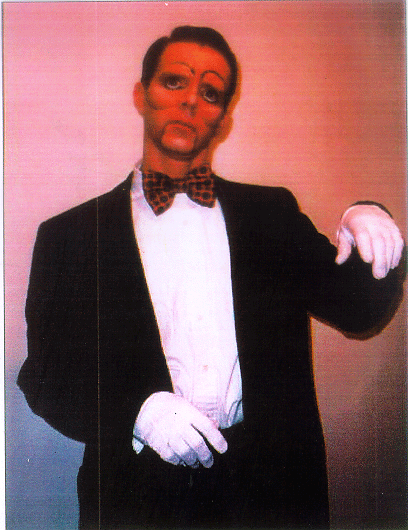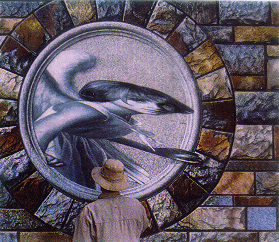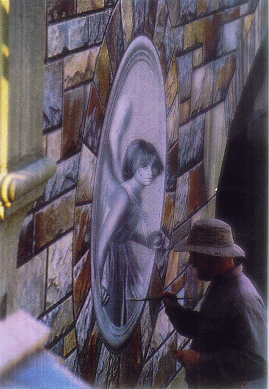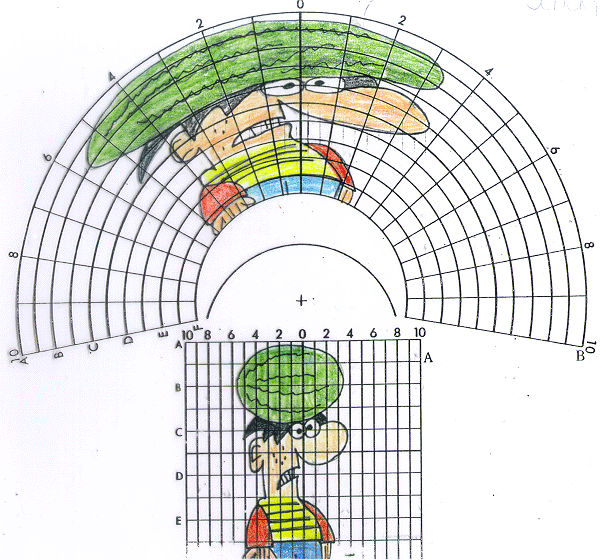Communicating
Science with the Arts
Chris Chiaverina
1. Introduction
For the last twenty-five years, at New
Trier High School in Winnetka, Illinois, we have been incorporating
elements of the visual and performing arts in our physics classes.
We have found that the arts serve as very effective vehicles for teaching
a variety of topics in physics and illustrating applications of physical
principles in the humanities.
While there are many ways to incorporate
the arts in physics instruction, we have essentially used three approaches.
These are: 1) interdisciplinary collaborations with the art and theater
departments; 2) the inclusion of art-related material in the physics
curriculum; 3) interactive gallery displays. I would now like to elaborate
on these efforts.
2. Interdisciplinary Collaborations
Physics and the Theater
Each year we schedule a day of interdisciplinary
activities with the performing arts department. The collaboration affords
physics and performing arts students an opportunity to examine auditorium
acoustics, e.g., reverberation time and interference effects, and the
art and science of stage lighting.
Students experience acoustical interference
patterns produced by two sources of sound, two speakers that approximate
point sources. They move around the auditorium and locate points where
the sound level is low. By using a large number of students, an easily
discernable nodal pattern emerges.
After investigating auditorium acoustics, we invite students to join
us on the stage to observe how the color of objects is affected by
color of the incident light. Students first observe the color of their
clothing under white light. The white light is then turned off and
each primary color is used in turn to illuminate the stage and its
occupants. Students are amazed by the dramatic changes in the perceived
color of their clothing that accompanies changes in lighting.
The Art and Science of Birefringence
A New Trier art teacher and I have been bringing our classes together
to produce works of art using polarized light. Our weeklong program
introduces art and physics students to color theory, polarization and
artistic composition. The week begins with an exploratory activity
on color and color mixing. Following this experience, students hear
about color from both physicist’s and artist’s points of
view. Students then return to the lab to investigate polarization.
During the course of this activity they encounter birefringence.
A discussion of polarization is followed
by a lesson on composition. Students are then ready to produce their
tape art.
The birefringent tape used in this activity
reveals beautiful colors when viewed between crossed polarizers. Students
layer tape on microscope slides to determine how color depends on tape
thickness. Once they have created their color key, they produce polarization
tape art by placing carefully cut pieces of tape on a plastic substrate.
The resulting work is often reminiscent of stained glass or cubist
art.
3. Art in the Physics Classroom
Shadows
We begin our study of geometric optics
with an exploratory activity on shadows. After students become familiar
with the rudiments of shadow formation and rectilinear propagation,
we delve into the importance of shadows in visual perception and art.
Artists employ numerous visual cues to
produce the illusion of depth and three-dimensionality. Shadows are
one of the most potent of these visual devices. Renaissance artists
are attributed with initiating the use of shadows in drawings and paintings.
This use of light and shadow in painting became known as chiaroscuro
(“light and dark”).
We introduce our students to chiaroscuro
by showing them a number of paintings that illustrate the technique.
We also bring in theater instructor Christopher Rutt to give them a
lesson in the power of shadows. Using only make-up to create the illusion
of shadow and light, he transforms his face with dramatic three-dimensional
features (Fig. 1).

Figure 1: Christopher Rutt demonstrates the power of shadows. Using
makeup to create false shadows, he has greatly accentuated his facial
features.
Anamorphosis
Anamorphosis is a process that stretches
and distorts images beyond recognition through the sophisticated application
of the laws of perspective. However, when viewed from the proper angle
or, in some instances, with the aid of a reflector, the distorted images
appear quite normal. Anamorphic
art, which flourished during the seventeenth and eighteenth centuries,
is now regarded as an artistic curiosity.
Leonardo da Vinci is often cited as the
first to experiment with anamorphosis. His form of anamorphic art did
not require the use of mirrors, only the correct point of view. Using
this approach, known as perspective anamorphosis, distorted images
become intelligible when viewed from a particular angle. This technique
was later used by Hans Holbein to conceal a skull in the famous anamorphic
painting titled The Ambassadors.
Although the popularity of this rather arcane art form waned after
the Renaissance, practitioners of anamorphosis may still be found today.
For example, contemporary artist William Cochran has created a delightful
anamorphic mural of a young woman on the side of a bridge in Frederick,
Maryland. Like Holbein’s Ambassadors, Cochran’s painting
is best viewed from a particular vantage point. (Figure 2).


Figure 2: William Cochran's anamorphic mural Archangel on a bridge
in Frederick, Maryland (a) viewed straight on; (b) at the intended
viewing angle. (Courtesy of the artist.)
We attempt to keep anamorphosis alive by introducing it to our physics
students during our unit on mirrors. During their study of curved reflectors,
our students create their own anamorphic art by first drawing an image
on a rectangular grid. Then, point-by-point, they transfer their image
to a cylindrical grid. This deforms their drawing. To see their drawing
in its undistorted form, they view it in a cylindrical reflector (Fig
3).

Figure 3: A drawing on a rectangular grid is mapped onto a cylindrical
coordinate system; the distorted drawing is transformed into a recognizable
image by reflection in a cylindrical mirror.
After Images and Pop Art
The eye/brain system is capable of retaining an image for a fraction
of a second after the stimulus is removed. This phenomenon, known as
persistence of vision, gives rise to after images. Our students learn
about persistence of vision and after images through a series of stroboscopic
demonstrations. They also discover the importance of after images to
an art movement that was born in the ‘70’s known as optical
art or “op art.”
Overlaying two identical patterns on the overhead projector produces
a Moiri pattern. When one of the patterns is displaced with respect
to the other, movement is observed. The same effect is also seen with
a single transparency. Due to the superposition of a current retinal
image and a previous image that the eye/brain retains, the viewer perceives
a Moiri pattern. The eye’s constant scanning motion makes the
Moiri pattern change in time, giving the illusion of motion. The sense
of motion we experience when viewing op art seems to be the result
of these constantly changing virtual Moiri patterns.
Camera Physics
Students build pinhole viewers and learn
about the workings of a camera by taking one apart. With the popularity
of single-use cameras, it is possible to obtain a class set of used
disposable cameras from most camera stores.
Students examine the camera’s optics
(these inexpensive cameras sometimes have up to three lenses!), flash
electronics and film transport mechanism. They form images with the
camera’s principal lens and measure its focal length and f-number.
Dissecting and analyzing a camera is one of our students’ favorite
activities.
Holography
In 1999, Dr. Tung Jeong, professor emeritus
at Lake Forest College, spent a week with us as a scientist in residence.
He met with students and staff in both large and small groups to discuss
the art and science of holography. As a result of his visit, each year
all physics students at New Trier (approximately 700) make their own
reflection holograms.
While the artistic community is still discussing
the merits of holography as an art form, it should be remembered that
photography experienced a similar scrutiny a century ago.
4. Gallery
Displays
The Connections Project
Teachers and students from three departments
at New Trier have produced over 125 engaging hands-on exhibits that
allow people of all ages to discover elements common to the arts, mathematics,
and science. Supported by New Trier High School and Toyota TAPESTRY
and GTE GIFT grants, the Connections Project has developed cross-curricular
displays that have been used in elementary, secondary and college classrooms
and laboratories, learning centers, art galleries, and other public
venues.
Both physiological and cognitive mechanisms
come into play when we view a work of art. Consequently, like San Francisco’s
Exploratorium, many of our exhibits examine how the eye-brain system
receives and processes visual information. An exhibition focusing on
the relationship between art and visual perception is currently being
presented at New Trier High School. To learn more about The Connections
Project, see the Fall 1996 issue of the Forum on Education.
Chris Chiaverina teaches physics at New Trier High School in Winnetka,
Illinois. With Thomas Rossing he co-authored Light Science, an optics
text written with the visual artist in mind. Chiaverina is
currently President of the American Association of Physics Teachers.
|